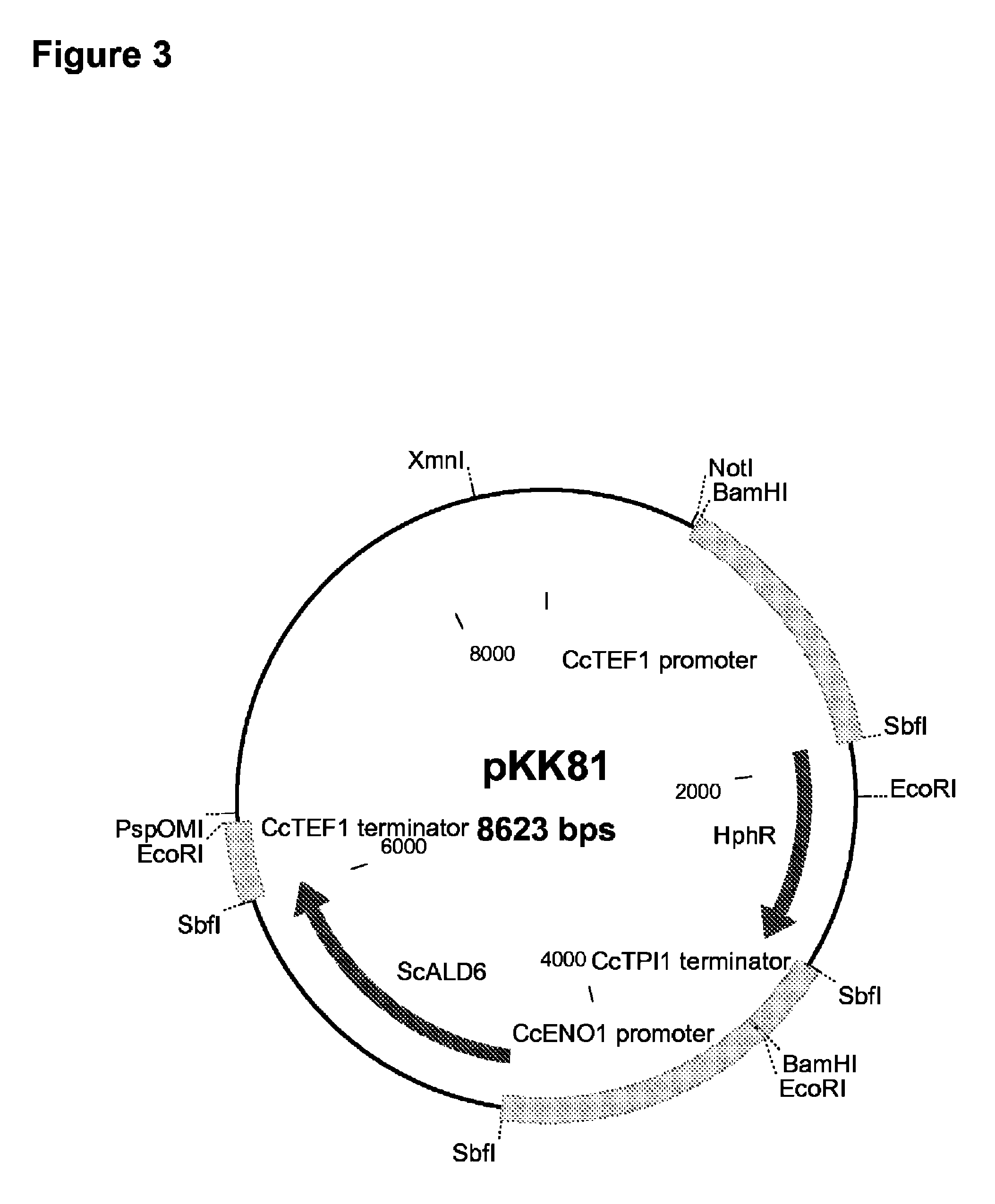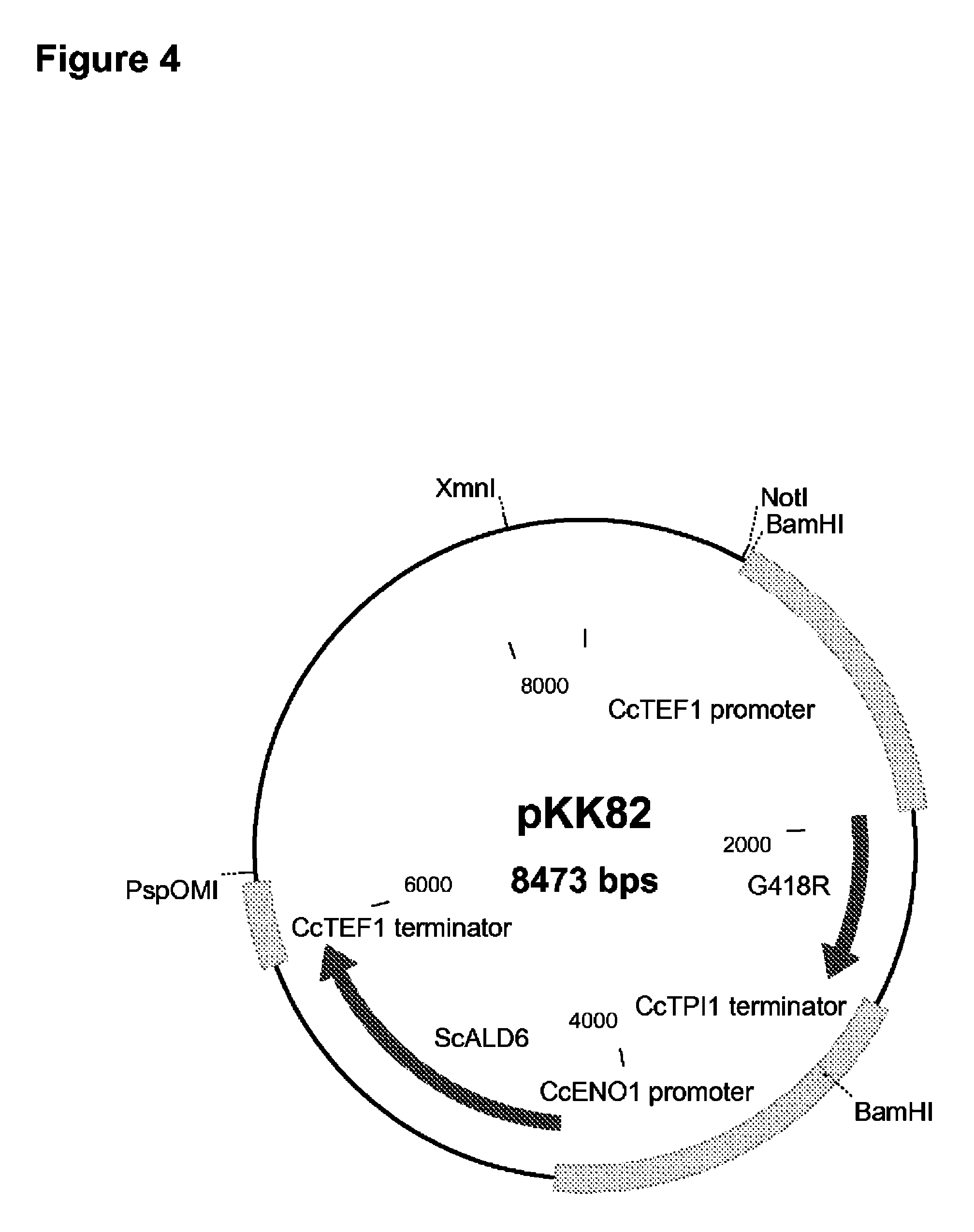Genetically modified fungi and their use in lipid production
a technology of microbial lipids and fungi, applied in the field of fungi, can solve the problems of low triglyceride production rate compared e.g. to yeast ethanol production, inability to significantly enhance inability to achieve significant enhancement of triacylglycerol production per cell biomass, etc., to achieve the effect of enhancing the activity of diacylglycerol acyltransfer
- Summary
- Abstract
- Description
- Claims
- Application Information
AI Technical Summary
Benefits of technology
Problems solved by technology
Method used
Image
Examples
example 1a
Cloning of Cryptococcus curvatus TEF (CcTEF1) Promoter and Terminator Region
[0125]A genomic ˜800 bp fragment of the C. curvatus TEF gene was amplified by PCR with degenerative primers identified as SEQ ID NO:1 (Yeast TEF1), and SEQ ID NO:2 (Yeast TEF4), using C. curvatus (C-01440, VTT Culture Collection) genomic DNA as the template. The degenerative primers were designed based on a consensus sequence of the putative TEF1 genes of Ustilago maydis, Candida guilliermondii and Candida tropicalis. The detected genomic fragment was sequenced.
[0126]Genomic fragments containing the CcTEF1 promoter region were obtained with ligation-mediated PCR amplification (Mueller, P. R. and Wold, B. 1989). A mixture of a linker identified as SEQ ID NO:3 (PCR linker I), and a linker identified as SEQ ID NO:4 (PCR linker II) was ligated to PvuII digested C. curvatus genomic DNA with T4 DNA ligase (New England BioLabs). Samples of the ligation mixtures were used as templates for 50 μl PCR reactions contain...
example 1b
Cloning of Cryptococcus curvatus TPI (CcTPI1) Promoter and Terminator Region
[0131]A genomic fragment of the C. curvatus TPI1 gene was amplified by PCR from genomic C. curvatus (C-01440, VTT Culture Collection) DNA with degenerative primers identified as SEQ ID NO:15 (Yeast TPI5), and SEQ ID NO:16 (Yeast TPI8). The degenerative primers were designed based on a consensus sequence of the TPI1 genes of Ustilago maydis and Cryptococcus neoformans. A ˜800 bp genomic fragment was isolated and sequenced.
[0132]A genomic fragment containing the CcTPI1 promoter region was obtained with a ligation-mediated PCR amplification with TPI1 gene specific oligonucleotides identified as SEQ ID NO:17 (CC_TPI2), and SEQ ID NO:18 (CC_TPI1), together with oligonucleotides identified as SEQ ID NO:3 (PCR Linker I) and SEQ ID NO:4 (PCR Linker II), similarly as in Example 1A except that EcoRV-digested C. curvatus DNA was used. A ˜1300 bp PCR fragment was isolated and sequenced.
[0133]The C. curvatus TPI1 promote...
example 1c
Cloning of Cryptococcus curvatus ENO (CcENO1) Promoter and Terminator Region
[0136]A genomic fragment of the C. curvatus ENO1 gene was amplified by PCR from genomic C. curvatus (C-01440, VTT Culture Collection) DNA with degenerative primers identified as SEQ ID NO:25 (YeastENO5) and SEQ ID NO:26 (YeastENO10). The degenerative primers were designed based on a consensus sequence of ENO1 genes of Ustilago maydis and Cryptococcus neoformans. A ˜1000 bp genomic fragment was isolated and sequenced.
[0137]A genomic fragment containing the CcENO1 promoter region was obtained with a ligation-mediated PCR amplification with ENO1 gene specific oligonucleotides identified as SEQ ID NO:27 (CC_ENO2) and SEQ ID NO:28 (CC_ENO1), together with oligonucleotides identified as SEQ ID NO:3 (PCR Linker I) and SEQ ID NO:4 (PCR Linker II), similarly as in Example 1A except that PvuII-digested C. curvatus DNA was used.
[0138]A ˜600 bp fragment was isolated and sequenced. Nested primers identified as SEQ ID NO:...
PUM
 Login to View More
Login to View More Abstract
Description
Claims
Application Information
 Login to View More
Login to View More - R&D
- Intellectual Property
- Life Sciences
- Materials
- Tech Scout
- Unparalleled Data Quality
- Higher Quality Content
- 60% Fewer Hallucinations
Browse by: Latest US Patents, China's latest patents, Technical Efficacy Thesaurus, Application Domain, Technology Topic, Popular Technical Reports.
© 2025 PatSnap. All rights reserved.Legal|Privacy policy|Modern Slavery Act Transparency Statement|Sitemap|About US| Contact US: help@patsnap.com



